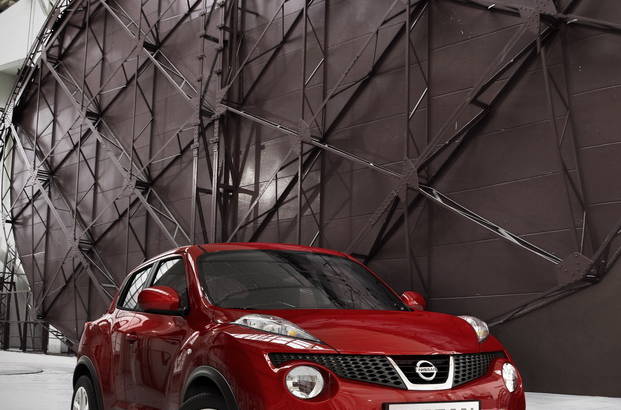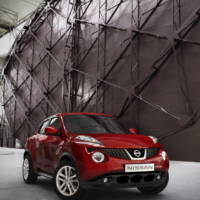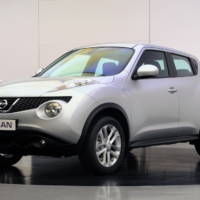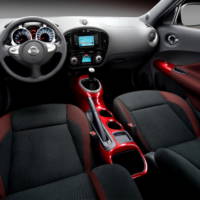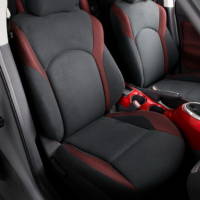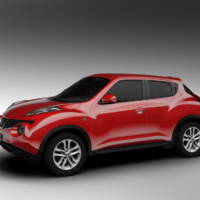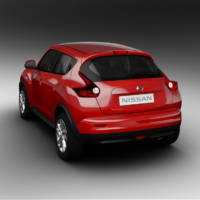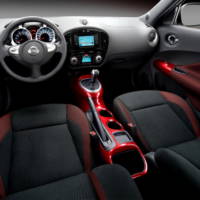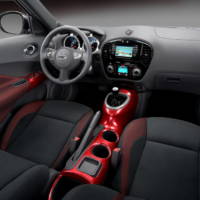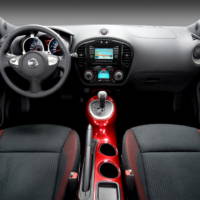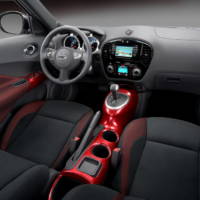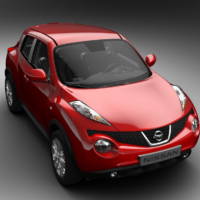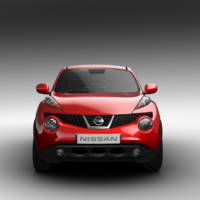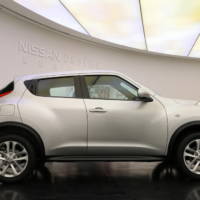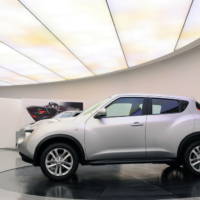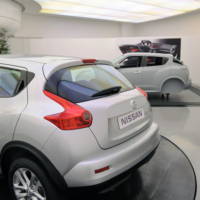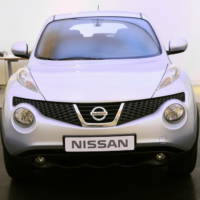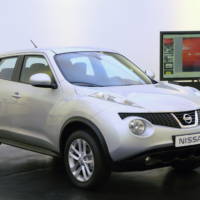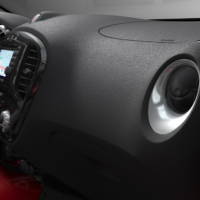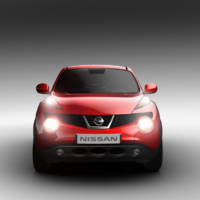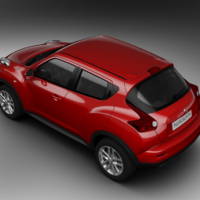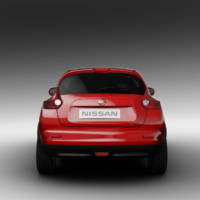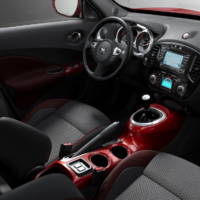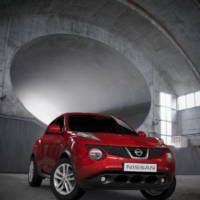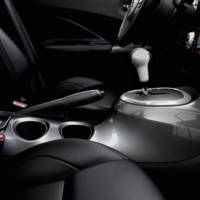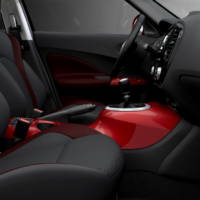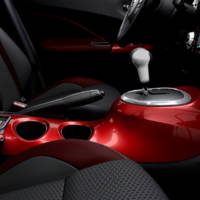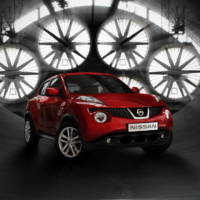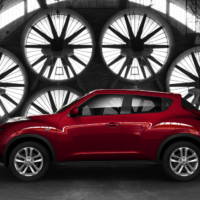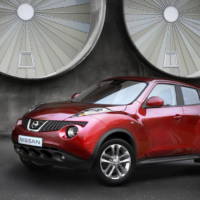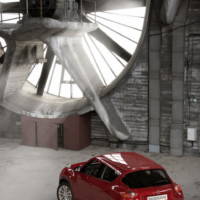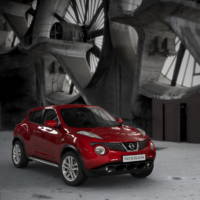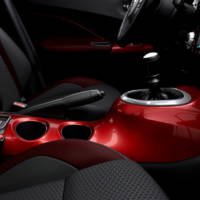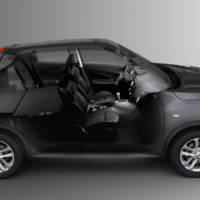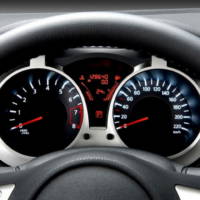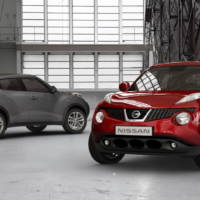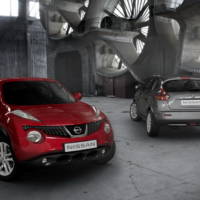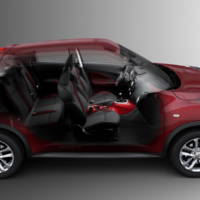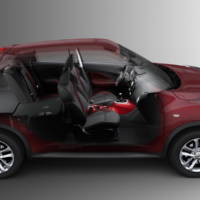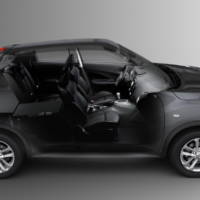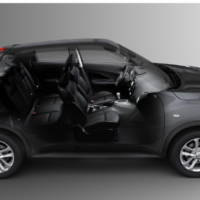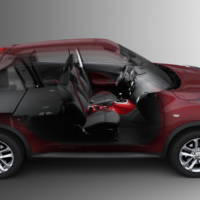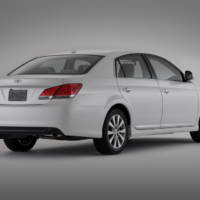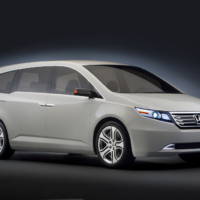Official photos plus the first video presenting the 2011 Nissan Juke small crossover have just been revealed ahead of the vehicle’s public debut at the 2010 Geneva Motor Show.
Powering options for the 2011 Nissan Juke include a wide range of engines that start with the 1.5-litre dCi turbocharged common rail diesel producing 110 PS (81 kW) ans 240 Nm of torque and continue with four 1.6-litre petrol units. The most powerful version 2011 Nissan Juke will be the 1.6i Turbo that packs 190 PS (140 kW) and 240Nm of torque.
The 2011 Nissan Juke price will probably get released as we get closer to the vehicle’s market launch date which is set for October. The 2011 Nissan Juke will be also sold on the North American market.
Nissan press release:
Nissan
is set to change the urban landscape… for the third time. Following in
the wheeltracks of the Murano large crossover and then the successful
Qashqai – the car that three years ago introduced the concept of a
crossover as an alternative to the traditional C-segment hatchback –
comes its younger brother, the Nissan Juke.
Designed to
bring a breath of fresh air to the B-segment, Juke is a distinctive
combination of SUV toughness and sporting style. Conceived to inject
some masculinity and dynamism into the small car market, Juke combines
a number of seeming contradictions beneath its highly individual lines.
“It
takes the best elements of an SUV and sports car and combines them,”
says Pierre Loing, Vice President, Product Planning, Nissan Europe.
“It’s roomy yet compact, robust yet dynamic and practical yet playful.
These are qualities that seem to contradict each other, yet come
together in Juke to create something that’s genuinely unique.”
Juke
was created at Nissan Design Europe (NDE) in the heart of London, and
refined at Nissan’s Design Centre (NDC) in Japan. Principle
engineering took place in Japan with significant European input and
Juke will be built in Nissan’s factory in Sunderland in the north-east
of England.
“The design shows real optimism. By combining
design elements from two genres to create a small, but striking
Crossover that displays a genuine confidence and style. And those are
qualities we also expect to find in a Juke customer,” said Shiro
Nakamura, Senior Vice President for Design and Chief Creative Officer
From
a design standpoint, the lower portion of Juke is pure SUV, with chunky
wheels, wide tyres, extended ground clearance and a robust stance. But
the top portion is unadulterated sports car, with a high waistline,
slim visor-like side glass graphics and a coupé-style falling roofline.
The coupé effect is further underlined by the rear doors which have
their handles hidden in the frame of the door.
Inside, the
sports car theme continues with a driver-focused cabin dominated by a
centre console design inspired by a motorcycle fuel tank. Finished in a
distinctive high gloss colour, the ‘bike’ console adds a sense of fun
to the car. Practicality is assured by the rear-opening hatch and
versatile luggage area with hidden storage opportunities.
Based
on the Renault Nissan Alliance B platform, Juke has a 2530mm wheelbase.
On front-wheel drive versions, suspension is by MacPherson struts at
the front with a torsion beam at the rear while four-wheel drive models
have a multi-link rear suspension modelled on the system found on
Qashqai.
The ALL-MODE 4×4-i is a new development of
Nissan’s respected electronic all-wheel drive system and now features
torque vectoring technology to enhance agility and reduce understeer
when cornering.
In Europe, three different engines will be
available when sales start later in the year (UK sales begin in
October): one diesel and two 1.6-litre petrol units, all fully Euro 5
compliant. At the top of the range is a new turbo-charged petrol engine
(MR16DDT) with direct injection. The engine is one of the most powerful
in its class, developing 140kW (190PS) and 240 Nm. The combination of
direct injection with a turbocharger provides the power and responses
expected from a 2.5-litre engine with the economy of a smaller engine.
The
second petrol engine is a newly developed version from Nissan’s trusted
HR-family. Designated HR16DE, the lightweight, low-friction 16-valve
unit now has a unique dual injection system allowing finer metering of
the fuel sprays for better combustion and develops 86kW (117PS). The
K9K 81kW (110PS) 1.5-litre dCi common rail diesel offers excellent
driveability – thanks as much to its heady 240 Nm of torque – with good
economy and emissions.
In terms of transmissions, the
two-wheel drive turbo-charged 1.6-litre petrol engine is available with
a six speed manual, while a CVT transmission with a six-speed manual
mode will be available on the range-topping all-wheel drive version of
the turbo-charged petrol engine.
The naturally aspirated
1.6-litre petrol is available either with a 5-speed manual or the
updated XTRONIC CVT and the 1.5-litre diesel engine is available with a
6-speed manual.
Trim and equipment options will follow the
established Visia, Acenta and Tekna lines while a full range of
accessories has been developed for owners who want to personalise their
Juke still further.
“Juke is not a traditional B-segment
car, and that is quite deliberate. It was born in an urban environment
and that is where it will spend most of its life. Fittingly, its
combination of agility and toughness make it one of the most streetwise
cars around.
“Juke joins Murano and Qashqai to cement
Nissan’s position as the leading brand in the crossover market,” said
Simon Thomas, Nissan’s European Senior Vice President for Sales and
Marketing.
Juke in detail
Exterior design
First
revealed as the Qazana show car – unveiled at the 2009 Geneva Motor
Show – Juke was created at the London-based Nissan Design Europe and
refined at Nissan’s Design Centre (NDC) in Japan. Qashqai, also created
at NDE, is sold in Europe, Asia and Australia while Juke will be
marketed in Europe, Japan and the United States.
“The
outcome of this global collaboration is a car that comes from where
East meets West, with vital contributions from NDE and NDC being key to
creating such a striking design,” said Shiro Nakamura.
Its
highly individual lines are carried over virtually intact from Qazana.
The boldness of the design reflects the significance of the B-segment
in the European market: Europe is expected to take the lion’s share of
sales ahead of the other main markets, including North America and
Japan.
The design team drew inspiration for Juke’s design
from a number of unusual sources. They looked back at a number of
vehicles synonymous with an active and sporting life – and that list
included rally cars and motorbikes. It’s clear to see where those ideas
have influenced the design.
The result combines a number of
different themes, but with Nissan DNA threaded through. It has a tough
solid body to reflect the SUV element, yet is a very sensual car, too,
with complex curves and a coupé profile accentuated by the narrow side
glass and hidden rear door handles which help give the impression of
two rather than four doors.
But there is also clear Nissan
family DNA in the design – the boomerang rear lights, for example, from
the 370Z – but none of the elements are slavishly copied so while
retaining Nissan DNA, Juke stands alone as a unique, almost maverick,
design.
This is a key theme running through Nissan designs.
Alfonso Albaisa, Vice President, Nissan Design Europe, says: “Juke has
elements inspired from other cars in our range such as 370Z and even
Cube, but our intention is never to make obvious links between our cars
but natural ones. Cube is a cool car, for example, and that coolness
can also be found in Juke.”
With generous ground clearance,
big wheels and tyres, a high waistline and a broad shoulder line, the
bottom ‘half’ of the car appears to be pure SUV. The impression is
accentuated by typical SUV features such as the contrasting black sill
and wheel arch finishers while at the front and rear, the lower
bodywork emerges from underneath the car, resembling underbody
protection.
At the front, the ‘sump guard’ forms part of
the air intake assembly but rather than use a simple meshed grille, the
design team have developed the moulding into a series of circular
slots… which are suggestive of biotic elements.
Above the
waistline, however, Juke shows its sporting credentials. A heavily
raked windscreen, complete with Nissan’s signature Crossover upswept
flick to the rearmost side window – and sloped roof-line provide a
profile reminiscent of an aircraft’s canopy.
The rear of
the roof incorporates an integral spoiler to reduce aerodynamic lift to
help high speed stability. The neat duck-tail ridge was perfected with
computational fluid dynamics (CFD) and tests in the wind tunnel.
The
lights also reflect the car’s sporting agility. At the front these are
split into two distinct elements. Framing the upper half of the bonnet,
thin slashes contain running lights and turn indicators, while the main
and dipped beams mounted lower on the nose of the car were inspired by
the auxiliary lamps fitted to rally cars in the sixties and seventies.
At the rear, the tail-lights put their own spin on the boomerang shaped
lamps found on the 370Z.
In total, a nine colour palette of
exterior colours is planned, including two whites, a solid and a pearl,
and three shades unique to Juke – Force Red, Haptic Blue and Machine
Brown, though the total availability will depend on region.
Seiji
Watanabe, Associate Product Chief Designer: "We want our cars, our
crossovers in particular, to have a spirit of agility, to be seen as
light, nimble, reactive. Juke displays all these attributes and
delivers a real sense of optimism.”
Interior design
Juke’s active, sporting exterior is matched by its interior… where the
dominant feature also displays a sense of fun: the centre console,
finished in a high gloss paint, resembles a motorcycle fuel tank.
“It’s unexpected,” says Alfonso Albaisa. “And that gives the interior a certain sexiness.”
Reflecting
the exterior’s blending of SUV and sports car attributes, the interior
provides the commanding driving position but with all the attributes
expected of a sports car. The gear shift sits on the top of the
‘motorbiketank’ to guarantee slick changes while the tank itself is no
mere styling statement but also provides a bracing point for the
driver’s knee during spirited cornering.
Similarly, the
central stack – which incorporates the new Nissan Dynamic Control
System – is ergonomically designed to ensure the driver has instant
access to the information and drive mode controls.
Attention
to detail is evident everywhere. Chrome fittings and high quality
materials are used throughout while the interior colours – red or gun
metal grey for the central console are available, depending on the
grade; black, silver or red accents to the leather or honeycomb
‘sports’ fabrics – underscore the car’s sporting attitude. Even the
door arm rests, shaped like flippers used by scuba divers, reflect an
active outlook.
Despite its overall compact dimensions, the
roomy interior offers competitive levels of space inside: front head
room and rear knee room will be sufficient for most occupants. Unlike
the Qazana show car, Juke is a full five seater.
The
practical luggage area is large enough to take a nine inch golf bag or
a maximum size suitcase and it also includes an underfloor storage area
(4wd versions excepted) which takes its potential capacity to 251
litres (VDA). In addition, the rear seats split 60:40, and also fold in
one simple movement to provide a totally flat loading floor.
To
hide luggage away from prying eyes, the trunk area has an integral
tonneau cover which differs from the conventional by being attached to
the tailgate and rises with the door when the trunk is opened.
“The
interior displays a number of attributes which really sum up the entire
car. There’s a lot of emotion here, a real sense of fun and a genuine
quality,” says Albaisa.
Platform
Juke
is based on Renault Nissan Alliance B-Platform and has a 2530mm
wheelbase, is 4135mm long, 1765mm wide and 1570mm tall. To allow the
top of the range to use 17-inch wheels and 215/55 R17 tyres, the track
front and rear is 1525mm, the widest yet seen on the Alliance
B-platform.
As new models evolve so a platform will
undergo a number of changes, and Juke’s underpinnings are no exception.
For its application on Juke, it has been lengthened, widened and
significantly strengthened and lightened to enhance safety, refinement,
and fuel efficiency.
Although the basic suspension system
mirrors that found on other B-segment cars, with MacPherson struts at
the front and a torsion beam at the back, a new cradle-type front
subframe has enhanced the lateral stiffness of the assembly. Along with
revised front suspension geometry, this has helped to promote better
handling and ride comfort along with greater refinement.
The
4wd versions of Juke further benefit from a new multi-link rear
suspension. When coupled to Nissan’s newly developed torque vectoring
four-wheel drive technology to limit understeer, Juke’s handling is at
the top of the class in spite of its higher ground clearance while
comfort has been preserved.
In an urban environment, the
combination of higher ground clearance and large tyres mean that speed
bumps and poor road surfaces will not cause as much discomfort – or
damage – as they would to a conventional sports hatchback.
Despite
its SUV looks and the comparatively high eye-point, Juke’s front and
rear roll centre heights are as low as possible – closer to a
conventional hatchback than a typical SUV – to reduce body roll in
corners.
Agile handling is also helped by speed sensitive
electric power steering, standard on all models, and by increased upper
body strength and stiffness. Juke incorporates a newly developed ring
structure which connects the upper body to the rear suspension, thus
increasing torsional rigidity.
Engines and drivetrains
In
Europe, there will be three engine and manual or CVT transmission
choices when Juke sales start in the second half of the year. At the
top of the range is a newly developed 1.6-litre Direct Injection
Gasoline turbocharged engine which develops 140kW (190PS) and 240Nm.
A
low friction and lightweight design, the 16 valve engine uses direct
injection to improve combustion to optimise power and torque, economy
and emissions. The addition of a turbocharger and intercooler helps to
boost power – this engine is one of the most powerful in its class –
while variable timing control for both intake and exhaust cycles (twin
VTC) improves low end engine response. A degree of overlap allows
exhaust gas recirculation.
Low friction techniques
include the adoption of diamond-like carbon (DLC) coating for the valve
lifters and mirror finish camshafts. The result is an engine delivering
the performance levels of a normally aspirated 2.5-litre engine but
with the fuel economy of a smaller engine.
The Direct
Injection Gasoline engine in two-wheel drive versions of Juke will be
coupled to a six-speed manual transmission. On the four-wheel drive
version, it will be mated to Nissan’s XTRONIC CVT transmission, with
six-speed manual mode.
The second petrol engine, which also
displaces 1.6-litres and has four valves per cylinder, is an
extensively reworked member of the HR family. Designated HR16DE, it has
undergone a number of significant changes with a larger exhaust
manifold, a retuned intake manifold, twin VTC, improved intake tumble
flow and new catalyst with a hexagon cell formation.
New
pistons with revised crowns and integral oil jet cooling have been
adopted along with low friction techniques such as diamond-like carbon
coating on the valve lifters.
But the most significant
change has been the development of a dual injector system – a world
first – which has two injectors for each cylinder, each with smaller
nozzles to deliver finer, more closely targeted sprays of fuel into the
cylinders for more efficient atomisation and more complete combustion.
Together
the changes have led to significant improvements in power, torque and
fuel economy. The engine produces 86kW (117PS), representing a six per
cent improvement over previous versions of the engine. Torque has
improved by three per cent to 157Nm while economy figures show a 5.6
per cent improvement. The normally aspirated petrol engine powers
two-wheel drive versions only, and will be available with either the
five-speed manual or the updated XTRONIC CVT transmission option, a
different CVT transmission to the one used with the DIG engine.
The
final engine choice is the familiar Alliance developed K9K 1.5-litre
dCi turbocharged common rail diesel. The 1,461cc eight-valve engine
delivers good fuel economy, low emissions and running costs with
excellent driveability.
With power rated at 81kW (110PS) at
4,000 rpm and torque at an impressive 240 Nm at 1,750 rpm this unit
features a fuel return rail and control unit for improved fuel
efficiency. Injection pressure is 1,600 bar. Improved glow plug
performance speeds up cold start performance. Emission control systems
include a diesel particulate filter (DPF), with a fifth injector for
regeneration and cooled exhaust gas recirculation while the
turbocharger layout altered to make the distance between it and the DPF
as short as possible.
The diesel will be available on
two-wheel drive models with the six-speed manual transmission. For
Europe, all the engines are fully Euro 5 compliant.
While
the manual transmission has been carried over largely unchanged from
Qashqai, both XTRONIC CVT systems feature a number of key technologies
that promise significant improvements in weight, packaging, performance
and fuel efficiency.
The updated XTRONIC CVT unit, used
with the conventional 1.6-litre petrol engine, is 10 per cent shorter
than before and 13 per cent lighter while internal friction has been
reduced by a remarkable 30 per cent. This unit is the world’s first CVT
with a sub planetary gear which allows a far higher transmission ratio
– 7.3:1 – than previous Nissan CVTs. Smaller, lighter pulleys, a
flexible lock up damper and a more efficient oil pump all promote great
fuel efficiency.
The XTRONIC CVT with 6-speed manual mode
in the turbocharged petrol-engined Juke has been tuned for a more
sporting performance with revised manual modes for sharper acceleration
while the management system has been reprogrammed to enhance fuel
efficiency. Both CVTs have adaptive shift control systems that can be
selected via the Nissan Dynamic Control System.
Unusually
in its class, Juke will be available with the option of four-wheel
drive in addition to conventional front-wheel drive. A newly developed
all-wheel drive system is based on Nissan’s ALL-MODE 4×4-i electronic
technology but which now adds a lateral torque-vectoring capability to
its armoury.
As well splitting torque front to rear – upto
a maximum of 50:50, it can now be split from side to side across the
rear axle, too. By monitoring vehicle speed, wheel speed, gear
position, steering angle, lateral G forces and now vehicle yaw rate,
torque distribution can be increased to the outside rear wheel in
corners to cut understeer and enhance the car’s cornering ability. In
total, upto 50% of the total available engine torque can be sent to
either rear wheel.
The new rear axle incorporates electric
couplings at either end plus a new final drive The inclusion of this
innovation is a first in the small car segment – a technology that has,
until now, only been found on top-of-the-range, premium vehicles.
The new system is noticeably lighter and more compact than similar systems used by some other manufacturers.
Range availability is as follows:
Engine Power Fuel Drive Transmission
1.5 dCi 81kW Diesel 2wd 6-speed manual
1.6i 86kW Petrol 2wd 5-speed manual
1.6i 86kW Petrol 2wd Updated XTRONIC CVT
1.6i Turbo 140kW Petrol 2wd 6-speed manual
1.6i Turbo 140kW Petrol 4wd XTRONIC CVT M6
Equipment and model lines
Just
about the only conventional aspect to Juke is the model line-up, which
follows Nissan’s established Visia, Acenta and Tekna lines. Lists of
standard and optional equipment will be released nearer the on sale
date, but expected items such as climate control, leather upholstery,
rear view camera and Intelligent Key will all be available to Juke
customers along with some more unusual features.
One such
is Nissan Dynamic Control System, a central command and display module
which allows the driver to alter dynamic drive settings as well as make
changes to more obvious functions such as climate control.
Cleverly,
the module adopts different displays, colours and functions depending
on how it is being used. In Climate mode, the display shows the
interior temperature setting while the ‘buttons’ display air-flow
preferences.
But in D-Mode, the buttons change to Normal,
Sport and Eco driving modes, altering throttle maps, torque
availability, CVT shift schedules, steering effort and even air
conditioning performance to suit the conditions. The display,
meanwhile, shows engine and drive related dials and information.
Car
settings, such as the sensitivity of automatic headlights, can also be
adjusted via the system, while the display changes colour to signify
what type of information is being displayed. Driving information
incorporates panels giving average speed, fuel economy, journey times
and so on. Overall, the display is designed to add a feeling of cool,
engaging technology to the interior.
Accessories
Although
Juke has a long list of standard equipment, Nissan has developed a full
range of accessories enabling owners to personalise their cars still
further. Among the items on offer are different designs of alloy wheel
as well as front and rear under body protectors to accentuate the SUV
element of the design.
Other exterior features include
exhaust finishers, a roof spoiler and wind deflectors on the doors,
while inside an owner can add illuminated door sills and interior
accent lighting. Practical touches include advanced security systems as
well as extra storage opportunities in the front armrest and in the
luggage area. .
European
Customers
“The
incredible success of our Qashqai compact crossover – we’ve recently
passed half a million sales in Europe alone – has shown that customers
are fed up with conventional cars. Juke is even bolder, even more
adventurous than Qashqai and is set to confirm Nissan’s position as a
pioneer of crossover in Europe and, indeed, globally,” says Simon
Thomas.
Juke has been conceived with the specific intention
to fulfil unmet customer expectations by adding much dynamism and
masculinity to the sober, safe small car market. Who does Nissan
imagine will buy Juke in Europe?
Clearly Urbanite, male
customers are expected to be predominant but a significant proportion
of buyers are anticipated to be women – one third according to Nissan’s
estimates. Nissan Juke will attract a younger audience than average
Nissan customers (under half will be below 40), these estimates shows
that Juke will have a broad appeal, supporting Nissan’s research that
there is widespread disillusionment at the lack of excitement in the
small car sector in Europe.
Sales of Juke will come
largely from the B-segment and is also expecting to attract C-segment
customers, with people trading down to enjoy something more radical and
inspirational. As with the successful Nissan Qashqai, a large majority
of Juke customers will be new to the Nissan brand.
2011 Nissan Juke Video

